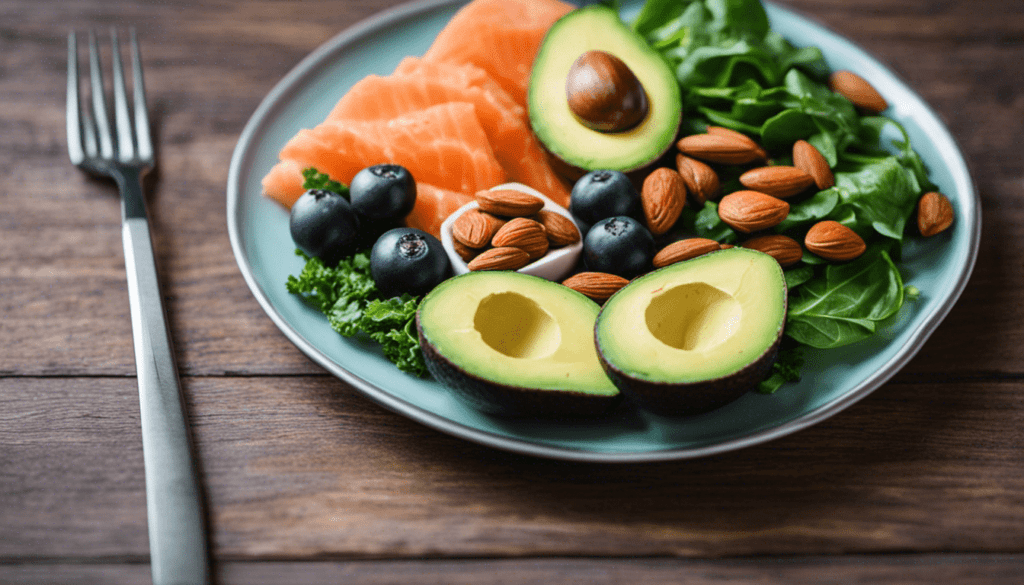Are you ready to dive into the world of keto but feeling overwhelmed by all the talk about net carbs? Don’t worry, we’ve got you covered.
In this article, we will be your guide as you navigate the ins and outs of net carbs on your keto journey. By understanding what net carbs are, identifying keto-friendly foods, and learning some essential meal planning tips, you’ll be well-equipped to stay on track and achieve your goals.
So let’s get started and make keto a breeze for beginners like you.
Key Takeaways
- Calculate net carbs by subtracting fiber and sugar alcohols from total carbs.
- Focus on low-carb snacks high in healthy fats and proteins.
- Balanced keto meals consist of protein, healthy fats, and low-carb vegetables.
- Track net carb intake and stick to the daily limit.
Understanding Net Carbs
Understanding net carbs is crucial when following a keto diet. Net carbs refer to the carbohydrates that affect your body’s blood sugar levels. To calculate net carbs, subtract the fiber and sugar alcohols from the total carbohydrates. This gives you the amount of carbs that will impact your blood sugar.
It’s important to be mindful of hidden sources of carbs, as they can easily derail your keto goals. Certain foods like fruits, starchy vegetables, and grains contain higher amounts of carbs. Additionally, processed foods often have hidden sugars and starches. Reading food labels carefully can help you identify these hidden sources.
Now that you understand net carbs and hidden sources of carbs, you can move onto the next section about identifying keto-friendly foods.
Identifying Keto-Friendly Foods
Identifying keto-friendly foods can be challenging, but it’s crucial for success on the ketogenic diet. When it comes to snacks, you want to focus on low-carb options that are high in healthy fats and proteins.
Nuts, such as almonds and macadamias, are great choices. They provide a satisfying crunch and can be easily carried with you. Cheese, both hard and soft varieties, is also a good option. It’s delicious and packed with protein.
When dining out on keto, opt for dishes that are centered around meat, fish, or poultry. Avoid carb-heavy sides like bread or pasta, and instead, choose salads or non-starchy vegetables. It’s important to remember that sauces and dressings may contain hidden carbs, so ask for them on the side or opt for olive oil and vinegar.
With these keto-friendly snacks and dining out tips, you’ll be well-prepared to make mindful choices.
Transitioning into meal planning for keto, let’s explore how you can create a menu that supports your goals without feeling restricted.
Meal Planning for Keto
When it comes to following a keto diet, creating a balanced meal is crucial for success. A balanced keto meal should consist of high-quality proteins, healthy fats, and low-carb vegetables.
To help you get started, here is a sample keto meal plan that incorporates these key points and can serve as a guide for creating your own balanced keto meals.
Creating a Balanced Keto Meal
To create a balanced keto meal, you’ll need to make sure you include a good source of protein, healthy fats, and low-carb vegetables.
Protein is essential for maintaining muscle mass and keeping you feeling full. Aim for about 3-4 ounces of protein per meal, such as chicken, fish, or tofu.
Healthy fats, like avocado, olive oil, and nuts, provide energy and help your body absorb vitamins.
When it comes to vegetables, choose low-carb options like leafy greens, broccoli, and cauliflower.
Portion control is important on the keto diet, so be mindful of the amount of food you eat.
If you need a snack, opt for keto-friendly options like almonds, cheese, or celery with peanut butter.
Now, let’s dive into a sample keto meal plan that incorporates these principles.
Sample Keto Meal Plan
Let’s take a look at a sample keto meal plan that incorporates these principles. Planning your meals ahead of time can help you stay on track with your keto journey. Here’s a simple meal plan to get you started:
Breakfast: Start your day with a veggie omelet made with eggs, spinach, and mushrooms.
Lunch: Enjoy a grilled chicken salad with mixed greens, avocado, and olive oil dressing.
Dinner: Try a delicious salmon fillet with roasted asparagus and a side of cauliflower rice.
Snacks: Keep some keto-friendly snacks on hand, like almonds, cheese sticks, or celery with peanut butter.
Remember, meal prepping is key to staying consistent with your keto diet. Prepare your meals in advance to avoid reaching for unhealthy options when you’re hungry.
With these meal prepping tips and a well-planned keto meal plan, you’ll be on your way to achieving your health goals.
Now, let’s dive into how you can stay on track with keto without feeling overwhelmed.
Staying on Track with Keto
You can easily stay on track with keto by tracking your net carb intake and sticking to your daily limit. Managing cravings is an important aspect of staying consistent with your ketogenic lifestyle. When those cravings hit, opt for keto-friendly snacks like nuts, cheese, or vegetables with dip.
Incorporating intermittent fasting can also help you maintain ketosis and manage cravings. By extending the time between meals, you give your body a chance to burn stored fat for fuel. Start with a 12-hour fasting window and gradually increase it to 16 or even 18 hours if you feel comfortable.
Remember to stay hydrated and listen to your body’s hunger and fullness cues. By following these strategies, you can successfully navigate the challenges of staying on track with keto.
Now, let’s move on to troubleshooting common challenges.
Troubleshooting Common Challenges
Now that you have a good understanding of how to stay on track with your keto diet, let’s dive into troubleshooting common challenges that you may encounter along the way. Two common challenges that keto beginners often face are overcoming cravings and managing the keto flu. Cravings for sugary and carb-loaded foods can be intense, especially in the beginning. To overcome these cravings, it’s important to have a plan in place. Stock your pantry with keto-friendly snacks such as nuts, seeds, and cheese to satisfy your cravings without derailing your progress. Additionally, staying hydrated and ensuring you’re getting enough electrolytes can help alleviate the symptoms of the keto flu, which can include fatigue, headaches, and nausea. Let’s take a look at some strategies for overcoming cravings and managing the keto flu:
| Overcoming Cravings | Managing Keto Flu | Staying Hydrated |
|---|---|---|
| Stock keto-friendly snacks in your pantry | Increase electrolyte intake | Drink plenty of water |
| Plan your meals and snacks in advance | Get enough rest | Incorporate herbal teas and broths |
| Distract yourself with activities | Gradually reduce carbohydrate intake | Add a pinch of salt to your water |
| Practice mindful eating | Incorporate more healthy fats | Use sugar-free electrolyte supplements |
| Seek support from a keto community or group | Consider intermittent fasting | Eat foods with high water content |
Frequently Asked Questions
Can I eat as much keto-friendly food as I want, as long as it’s low in net carbs?
You can enjoy unlimited amounts of keto-friendly food that is low in net carbs. This allows for carb-free indulgence while still maintaining a ketogenic diet. Focus on choosing nutrient-dense options to support your overall health.
Can I drink alcohol on the keto diet?
Yes, you can drink alcohol on the keto diet, but in moderation. Alcohol consumption can slow down ketosis and affect weight loss. Limit high-carb drinks like beer and sugary cocktails, and choose low-carb options like vodka or dry wine instead.
Can I have cheat days or meals while on the keto diet?
Yes, you can have cheat days or meals while on the keto diet. However, it’s important to plan and strategize to minimize the negative impact. Cheat days can provide mental relief and prevent feelings of deprivation, but moderation and balance are key.
Can I follow the keto diet if I am a vegetarian or vegan?
Yes, you can absolutely follow the keto diet if you’re a vegetarian or vegan. There are plenty of delicious vegetarian keto recipes available, and vegan alternatives for high-fat foods like avocado, coconut, and tofu.
Can I consume artificial sweeteners while on the keto diet?
Yes, you can consume artificial sweeteners while on the keto diet. They can be a useful tool to satisfy your sweet tooth without adding extra carbs. However, it’s important to be aware of the pros and cons of artificial sweeteners.
Conclusion
In conclusion, as you embark on your keto journey, it’s crucial to understand the concept of net carbs and how they affect your body.
By identifying keto-friendly foods and incorporating them into your meal planning, you can stay on track and achieve your goals.
Remember, staying consistent is key to success on the keto diet. Interestingly, a study found that individuals following a well-formulated ketogenic diet experienced greater weight loss and improved metabolic markers compared to those on a low-fat diet.
So, stay committed and enjoy the benefits of a healthier, low-carb lifestyle!








